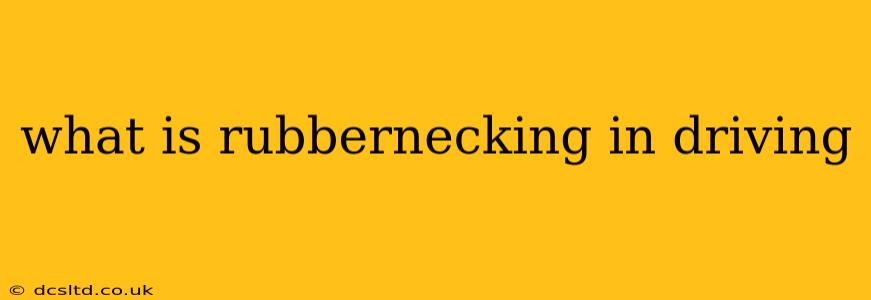Rubbernecking, in the context of driving, refers to the act of slowing down or stopping to look at an accident, incident, or something unusual on the side of the road. It's more than just a quick glance; it involves significantly reducing speed or completely halting to gawk, often causing traffic congestion and, more importantly, increasing the risk of secondary collisions. This seemingly innocuous behavior can have serious consequences, impacting not only the drivers involved but also potentially those who are already in precarious situations.
Why is Rubbernecking Dangerous?
The inherent danger of rubbernecking stems from its disruptive effect on traffic flow. When drivers slow down suddenly to look at an incident, they create a chain reaction, causing a ripple effect of slowing and braking further down the road. This can lead to:
- Rear-end collisions: The most common consequence. Drivers following too closely are often unable to stop in time when the car in front suddenly brakes to rubberneck.
- Side-swipe accidents: Slowing down unexpectedly can cause drivers to lose control, potentially leading to collisions with vehicles in adjacent lanes.
- Increased congestion: Rubbernecking significantly slows traffic, leading to frustration, increased commute times, and a generally unsafe driving environment.
- Distraction: The act of rubbernecking itself is a major distraction, taking the driver's attention away from the road and increasing the risk of accidents.
What Causes Rubbernecking?
Several factors contribute to rubbernecking:
- Curiosity: Humans are naturally curious, and seeing an unusual event on the road often triggers an instinctual urge to look.
- Lack of awareness: Some drivers may not fully understand the risks associated with slowing down or stopping to look at an incident.
- Social pressure: The collective slowing down of other drivers can create a sense of social pressure to do the same, even if a driver initially had no intention of rubbernecking.
How Can I Avoid Rubbernecking?
Being mindful and taking preventative measures can help avoid this dangerous driving habit:
- Maintain a safe following distance: This provides more reaction time if the car in front suddenly brakes.
- Keep your eyes on the road: Focus on driving, not on the roadside incident.
- Be aware of your surroundings: Anticipate potential hazards and adjust your driving accordingly.
- Avoid looking directly at the accident or incident: A quick glance is acceptable, but prolonged staring is extremely risky.
- If possible, change lanes: If you can safely do so, move to a lane away from the incident to avoid being caught in the slowing traffic.
Is Rubbernecking Illegal?
While there isn't a specific law against "rubbernecking," the actions involved, such as reckless driving, obstructing traffic, or causing a collision, could lead to legal consequences, including fines, license suspension, or even criminal charges depending on the severity of the situation.
What are the penalties for rubbernecking?
Penalties for rubbernecking aren't directly defined but are determined by the resulting consequences. For example, causing an accident due to rubbernecking could lead to significant fines, legal action from other involved parties, insurance hikes, and potential license suspension.
How does rubbernecking affect traffic flow?
Rubbernecking severely impacts traffic flow, creating bottlenecks, increased congestion, and significantly longer commute times. The sudden slowing and stopping of multiple vehicles can create a ripple effect, causing widespread delays and frustration among drivers.
In conclusion, rubbernecking is a dangerous driving habit with potentially severe consequences. By understanding the risks and implementing safe driving practices, we can all contribute to safer roads for everyone. Remember, a quick glance might satisfy your curiosity, but maintaining a safe driving distance and focusing on the road is paramount to preventing accidents and ensuring a smooth traffic flow.
